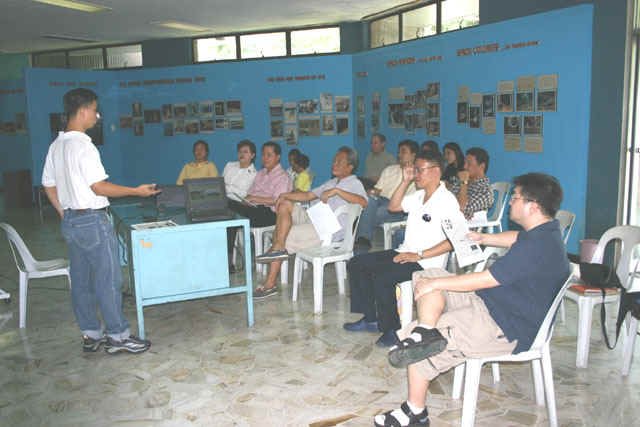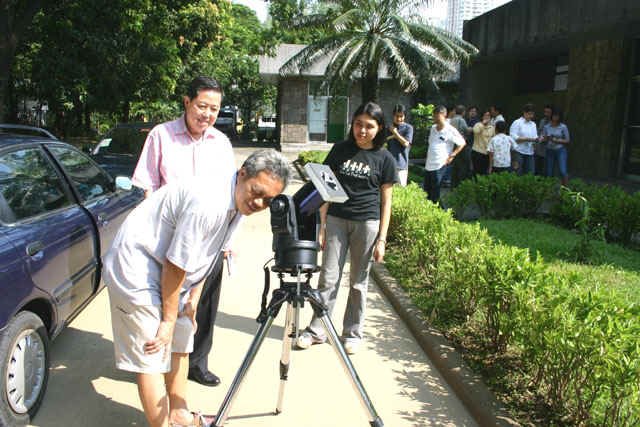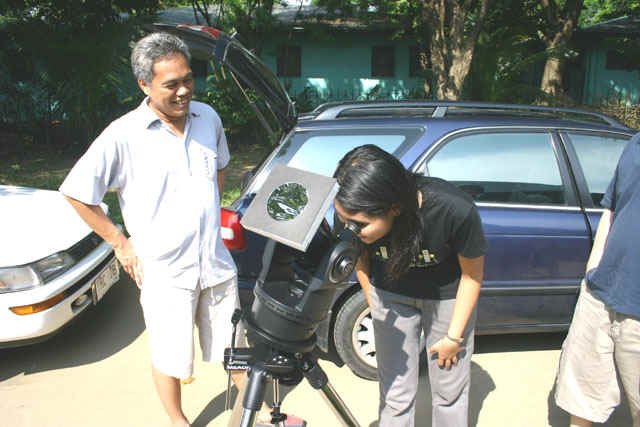| The Astronomical League of the Philippines held its monthly meeting at the Manila
Planetarium in Luneta Park. Among the ALP members who attended the event were James
Kevin Ty, Allen Yu, Alice Villa-Real, Rich Pijuan, Alfonso Uy, Dr. Jett Aguilar,
Dante Cruz, Alexander Loinaz, Joseph Torres, Melchor Pilones, Bel Pabunan, Joey Grajeda,
Hans Gideon Cerdenia, Jomar Lacson, Lea Visaya , Greten Vicke Estella and new member
Kristy Anne Abello. The meeting started at around
2:30pm and ALP treasurer  Allen Yu gives an update on the IAU
decision to demote the planet Pluto. To be a planet, the assembly ruled, a
world must meet three criteria: Allen Yu gives an update on the IAU
decision to demote the planet Pluto. To be a planet, the assembly ruled, a
world must meet three criteria:
(1) It must have enough mass and gravity to gather
itself into a ball.
(2) It must orbit the sun.
(3) It must reign supreme in its own orbit, having "cleared the neighborhood" of
other competing bodies.
For instance, mighty Jupiter, which circles the sun supreme in its own orbit, is a
planet--no adjective required. Pluto, on the other hand, shares the outer solar system
with thousands of Pluto-like objects. Because it has not "cleared its own
neighborhood," it is a dwarf planet.
This decision clarifies the vocabulary of planetary astronomy while simultaneously
upturning 76 years of "Pluto is a planet" pop-culture. Will non-specialists heed
Pluto's demotion? That remains to be seen. Meanwhile, according to the IAU, the Solar
System has eight planets: Mercury, Venus, Earth, Mars, Jupiter, Saturn, Uranus and
Neptune; and three dwarf planets: Ceres, Pluto and 2003 UB313.
Afterwards, when the sky cleared out a little for the Sun to  shine, ALP president then brought out his portable Meade ETX-90AT equipped
with Baader Astro-Solar Filter to show the members what the Sun will look like that
afternoon. But the Sun gives a forgetful appearance as there were no visible sunspot
that was visible in the Sun's disk :( Although it is dull, some of the veteran
observers can see the Sun's granular appearance. Many of them like the portable
appearance of this small but nice telescope. The image and contrast were also very
good. How they wish they could also see the Sun in H-Alpha light! As you see, even
if the Sun in white light looks bland, in the narrow band light of H-Alpha, the Sun
sometimes has a lots of solar prominences and solar filaments visible! If anyone
could just have one of those H-Alpha scopes in the future :) LOL shine, ALP president then brought out his portable Meade ETX-90AT equipped
with Baader Astro-Solar Filter to show the members what the Sun will look like that
afternoon. But the Sun gives a forgetful appearance as there were no visible sunspot
that was visible in the Sun's disk :( Although it is dull, some of the veteran
observers can see the Sun's granular appearance. Many of them like the portable
appearance of this small but nice telescope. The image and contrast were also very
good. How they wish they could also see the Sun in H-Alpha light! As you see, even
if the Sun in white light looks bland, in the narrow band light of H-Alpha, the Sun
sometimes has a lots of solar prominences and solar filaments visible! If anyone
could just have one of those H-Alpha scopes in the future :) LOL
 James centering the Sun on the field of the
Meade ETX-90 AT while Planetarium curator Mel Pilones (left) and Joey Grajeda await their
turn at the scope. @ Alex Loinaz |
 ALP newest member Kristy Anne Abello got her first
chance to look at the Sun through the scope. |
Afterwards, Dr. Jett Aguilar gives a lecture on
the Moon. He tackles technical aspects of the Moon, then tone down later to
the interesting features that can be seen through a binoculars and telescope. Some
interesting features he explained were how to find the rabbit in the Moon, the Face of the
Woman in the Moon, Great craters like Tycho, Copernicus, etc. He also discuss on the
seasonal changes as well as how the Moon affect our tides. He tackles technical aspects of the Moon, then tone down later to
the interesting features that can be seen through a binoculars and telescope. Some
interesting features he explained were how to find the rabbit in the Moon, the Face of the
Woman in the Moon, Great craters like Tycho, Copernicus, etc. He also discuss on the
seasonal changes as well as how the Moon affect our tides.
He also discuss the upcoming September 8 Partial Lunar Eclipse
and invited the members to observe with the group at the PAGASA Observatory in UP-Diliman.
ALP will be setting up their equipment on the night of Sept 7 (Thursday) at 9:00pm.
The event will more or less start after midnight and will end at around 5:00am. So
let's hope the weather will be clear for all of us to observe the event.
Afterwards, James then discuss a little on his Mayon  expedition
with fellow ALP Treasurer Allen Yu last August 14-17. They were able not only able
to observe Mayon minor eruptions but also got a chance to be up close and personal with
lava flow at the foot of the volcano. He then show some images of the volcanic eruption as
well as some video clips that he was able to record at the lava flow site using his Nokia
N70 camera/video phone. The video highlights let the members get a feel on how near
the two are to the lava flow. They were more or less 3-5 meters away when taking the
images of the lava :) expedition
with fellow ALP Treasurer Allen Yu last August 14-17. They were able not only able
to observe Mayon minor eruptions but also got a chance to be up close and personal with
lava flow at the foot of the volcano. He then show some images of the volcanic eruption as
well as some video clips that he was able to record at the lava flow site using his Nokia
N70 camera/video phone. The video highlights let the members get a feel on how near
the two are to the lava flow. They were more or less 3-5 meters away when taking the
images of the lava :)
The meeting ended at around 5:30pm.
|


